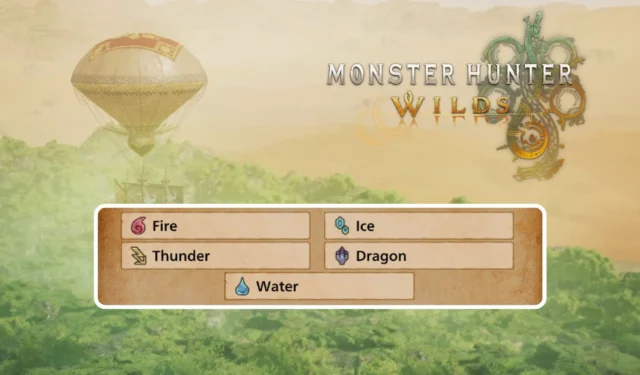Understanding Elemental Damage in Monster Hunter Wilds

In Monster Hunter Wilds, weapons are defined by three key stats: Attack, which denotes direct damage output; Affinity, representing the Critical Hit Chance; and Element, which remains somewhat obscure for players. Understanding these mechanics, particularly Elemental damage, is crucial for players looking to optimize their endgame builds and effectively hunt formidable monsters.
Understanding Elemental Damage in MH Wilds
Elemental damage represents a distinct form of damage that is calculated independently from physical damage. This type of damage is applied on top of your weapon’s raw attack value subsequent to all damage calculations. However, players should be aware that the Elemental damage listed on the weapon screen is inflated; for example, a weapon displaying 210 Elemental damage actually inflicts just 21 damage (210 divided by 10).Therefore, a weapon that claims 500 Elemental damage contributes merely 50 to your total damage output.
To gain a true understanding of how your weapon performs, you can adjust the Game Settings by switching the ‘Damage With Coefficient’ option to ‘Damage Without Coefficient’. While this adjustment reveals the accurate physical attack value, the Elemental damage value still appears inflated.
When engaging in combat with monsters, several additional factors influence the effective Elemental damage inflicted:
- Weapon Sharpness: A weapon’s sharpness affects Elemental damage directly. If the sharpness meter dips into the red, Elemental damage can suffer a significant decrease of -75%.In contrast, a weapon with green sharpness retains 100% efficiency, while sharper levels yield incremental increases.
- Monster Weakness: Different monsters exhibit varying vulnerabilities to Elemental damage, which can significantly enhance your effectiveness.
- Quest Difficulty: Higher difficulty levels result in reduced Elemental damage output.
- Monster Rage Status: The enraged state of a monster may alter the Elemental damage you inflict—depending on the species, it can lead to increased or decreased damage.
The calculation for total Elemental damage is thus represented by the following formula:
(Elemental damage value / 10 x Weapon Sharpness x Monster Elemental Weakness x Quest Difficulty x Rage Status)
Types of Elemental Damage in MH Wilds
Monster Hunter Wilds features five distinct types of Elemental damage, each offering unique advantages:
- Fire: Inflicts Fire damage.
- Water: Inflicts Water damage.
- Thunder: Inflicts Thunder damage.
- Ice: Inflicts Ice damage.
- Dragon: Inflicts Dragon damage.
It’s important to note that Elemental Blight status effects, such as Fireblight and Waterblight, can only be inflicted by monsters onto hunters, except for Blastblight, which operates as a status effect rather than standard Elemental damage.
Differentiating Elemental Attacks from Status Effects
While Elemental attacks and status effects are both categorized under Element in the weapon statistics, they serve distinct purposes.Elemental attacks deliver actual damage based on Elemental value, whereas status effects focus solely on building up a condition. For instance, a weapon marked with a 200 paralysis status ailment indicates how quickly it can inflict paralysis, and not the damage dealt to the monster itself.
Hunters can deploy six varieties of status effects in Monster Hunter Wilds:
- Sleep: Temporarily incapacitates the monster, granting bonus damage upon initial attack.
- Paralysis: Prevents the monster from moving for a brief duration.
- Poison: Gradually saps the monster’s health over time.
- Blastblight: Accumulates damage as you attack, culminating in an explosive detonation.
- Stun: Repeated head attacks with blunt weapons can knock out a monster momentarily.
- Exhaust: Over time, blunt damage will deplete the monster’s stamina.
Identifying Monster Elemental Weaknesses in MH Wilds
The Large Monster Field Guide is an invaluable resource for players, providing detailed charts on the elemental weaknesses of every encountered monster. These details can be found on the guide’s second page.
Crucially, each body part of a monster has different susceptibility levels to certain attacks. More stars on the weakness chart indicate a greater vulnerability. For example, the Zoh Shia is particularly weak to Dragon Element attacks aimed at its Head or Neck. Other Elemental attacks will still have an effect, but at a decreased damage rate, as indicated by fewer stars.
Interestingly, some monsters possess complete immunity to certain elements or specific Elemental attacks depending on conditions. For instance, Rey Dau is entirely immune to Thunder attacks, while Guardian Arkveld can withstand all Elemental attacks temporarily at its Left and Right Chainblade, and Yian Kut-Ku is resistant to Dragon assaults, except at its Neck, where it is vulnerable.
Top Weapons for Maximizing Elemental Damage in MH Wilds
One of the unique features of Elemental damage is its consistent scaling across various weapon types; whether using a Great Sword or Dual Blades, Elemental damage per hit remains largely uniform, given equal conditions. This consistency benefits high-speed weapons like Dual Blades and Insect Glaives, allowing them to fully exploit their Elemental damage potential.
In general, faster attacking weapons tend to be more advantageous for Elemental damage. While slower weapons can still utilize Elemental traits, players utilizing these weapons should focus more on raw physical damage and Affinity for optimal performance.
For players seeking the best options for Elemental damage in Monster Hunter Wilds, the following weapons stand out:
- Dual Blades
- Insect Glaives
- Charge Blade
Affinity and its Relationship with Elemental Damage in MH Wilds
Under standard conditions, Affinity (critical hit chance) does not impact Elemental damage directly. To leverage Affinity for Elemental attacks, players can employ the Critical Element Equipment skill, which boosts Elemental damage whenever a critical hit is landed. It’s crucial to note that the base Elemental damage is not multiplied; rather, it experiences a skill-induced increase, marking a subtle yet significant distinction.
Source&Images
Related Articles:
Top 10 Survival Games Featuring Soulslike Mechanics
14:03July 13, 2025Top 10 Metroidvania Games to Convert You into a Fan
13:05July 13, 2025Comprehensive Reggie Guide: Master the Art of Dating Everything
18:44July 12, 2025Top 10 Iconic Boss Fights From the PS1 Era
15:03July 12, 2025Stardew Valley: Reasons to Begin Anew in 2025
Upcoming Sci-Fi Anime from Attack on Titan Studio Set for April Release
Leave a Reply Cancel reply
Your email address will not be published. Required fields are marked *













